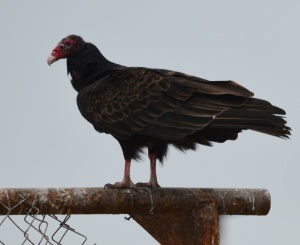“I like vultures,” a friend said when I mentioned my blog idea. “They kettle and they’re easily identified.”
They are, except when not yet in full adult uniform and hulking on a dead mesquite branch, head hunched Dracula-cape-esque. A sight I had one morning exiting the garage. Up close, the hulk was huge. Condor was my first thought, momentarily forgetting I was in Deep South Texas.
The bird lifted off with a powerful flap of wings, circled the Resaca then buzzed six feet over my head showing a great expanse of white on its under belly. Too big to be a hawk, but very little red in the head area.
Joining our friends for dinner that night, she brought out her three-volumn bird book that she said she never takes out of her house. She confirmed no condors here, although the same family, Cathartidae. Her coveted book showed pictures of both adult and juvenile birds. Our big bird was a juvenile turkey vulture, Cathartes aura.
The turkey vulture wingspan reaches to six feet. They can swoop up to 60 mph.
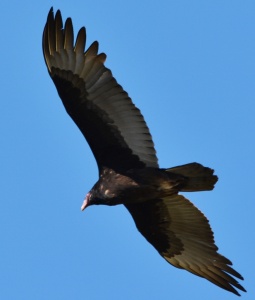
Living in the country, I’ve had occasion to watch vultures. The word tenacious comes to mind. While driving to my weekly nature park volunteer activity last week, on a busy road near the house, a vulture zipped up about six feet and then down, smack in the middle of the road. It repeated this with each passing car.
Four hours later, on my return trip, the same scene, vulture pecking at meal between car interruptions. My husband said it was there in the afternoon, too. I said, “I wonder why it didn’t just haul the road kill to the side of the road where it would be safer?”
Amazingly, my research gave an answer. Turkey vultures are unable to carry off their carrion. Their feet are chicken like, not talon-like as hawks or eagles. They are the only scavenger birds that can’t kill their prey.
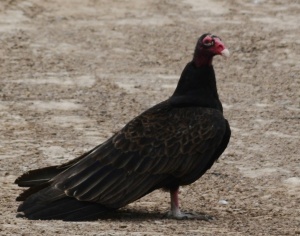
Their beak, however, can pierce through the toughest cow hide.
A turkey vulture’s diet consists entirely of dead animal remains. According to some literature, there is an opportune time as far as road kill — the fresher the better and too old is too old. Vultures prefer meat as fresh as possible and won’t eat extremely rotted carcasses. They can smell carrion less than 12-24 hours old.
Turkey vultures are among the very few birds that can smell. They detect carrion by sight, but also rely heavily on their sense of smell. They can sniff out a dead critter from more than a mile away. They’ve been known to cruise 30 to 50 miles in search of food.
Ornithologist Gary Graves in the Division of Birds at the Smithsonian’s National Museum of Natural History explained how turkey vultures find food. “They track plumes of odor from decaying animals while gliding high up in the air column and home in on it by flying in circles. Their sense of smell is so acute that they can even locate hidden food, say something as small as a dead rat under a pile of leaves.”
Apparently I’m not the only one envious of vultures’ fun in the sky.
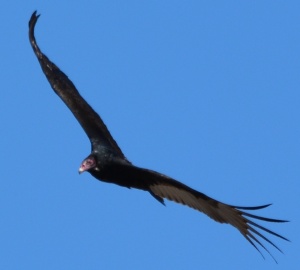
The Internet is full of interesting research. In spite of their large size, turkey vultures surprisingly only weigh between 2-4 pounds.
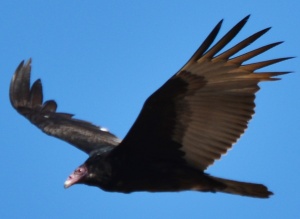
Because of their light weight, they can virtually float in the sky using the thermal currents (rising columns of air) to get around the skies. This technique uses very little energy as the vultures rarely need to flap their wings. One site mentioned that vultures are so efficient at finding thermals, hawks will look for kettles (vultures circling upward) and then fly over to take advantage of the rising air.
When flying, turkey vultures, hold their wings in a “V” above their backs, creating a slight angle that stabilizes their flight in turbulence.

Turkey vultures possess an unusual defense mechanism — they regurgitate their last meal. Apparently a worse smell than decaying meat and effective against any predator with a sense of smell.
If you’ve kept up with my blogs, you know I love collective bird nouns. I found, a colony, or committee, of vultures. In the morning, vultures may be seen perched with their wings spread to absorb ultraviolet rays of the sun. This would be a wake of vultures.
According to one site, their scientific name, Cathartes aura, provides a clue to their place in the ecosystem. Cathartes comes from the Greek word meaning “purify,” and purify they do as they scavenge the landscape, eating carrion.
Beautiful when effortlessly soaring on the thermals with their wings outstretched like a bi-plane, up close, their bare-skinned red head with greenish warts and hooked white bill do not an attractive bird make. Still, I do not hold back respect for the much-needed environmental service these carrion scavengers perform: the Waste Management conglomerate of Mother Earth.
